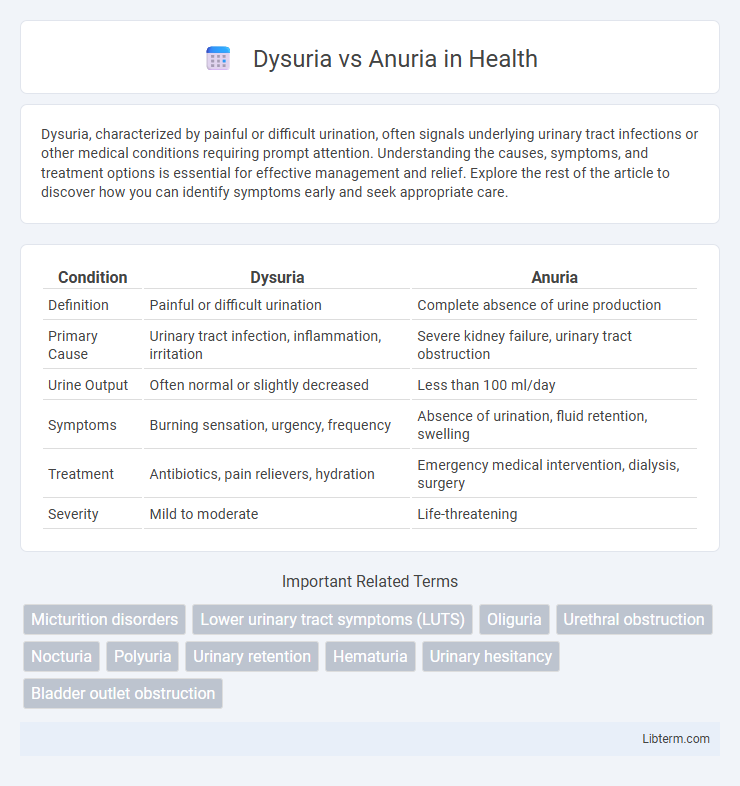Dysuria, characterized by painful or difficult urination, often signals underlying urinary tract infections or other medical conditions requiring prompt attention. Understanding the causes, symptoms, and treatment options is essential for effective management and relief. Explore the rest of the article to discover how you can identify symptoms early and seek appropriate care.
Table of Comparison
| Condition | Dysuria | Anuria |
|---|---|---|
| Definition | Painful or difficult urination | Complete absence of urine production |
| Primary Cause | Urinary tract infection, inflammation, irritation | Severe kidney failure, urinary tract obstruction |
| Urine Output | Often normal or slightly decreased | Less than 100 ml/day |
| Symptoms | Burning sensation, urgency, frequency | Absence of urination, fluid retention, swelling |
| Treatment | Antibiotics, pain relievers, hydration | Emergency medical intervention, dialysis, surgery |
| Severity | Mild to moderate | Life-threatening |
Introduction to Dysuria and Anuria
Dysuria refers to painful or difficult urination often caused by urinary tract infections, inflammation, or irritation, while anuria is characterized by the complete absence of urine output, commonly resulting from severe kidney dysfunction or urinary obstruction. Dysuria symptoms include burning sensations, urgency, and increased frequency, whereas anuria signals critical renal failure or obstructive uropathy requiring immediate medical evaluation. Understanding these distinct conditions is essential for accurate diagnosis and effective treatment of urinary disorders.
Defining Dysuria: Causes and Symptoms
Dysuria is characterized by painful or difficult urination, often caused by urinary tract infections, bladder inflammation, or sexually transmitted infections. Common symptoms include a burning sensation during urination, increased frequency, and urgency. Differentiating dysuria from anuria, which is the complete absence of urine output, assists clinicians in diagnosing underlying conditions affecting the urinary system.
Understanding Anuria: Key Characteristics
Anuria is characterized by the complete absence of urine output, typically less than 100 milliliters per day, indicating severe kidney dysfunction or urinary tract obstruction. Unlike dysuria, which refers to painful or difficult urination often caused by infections or inflammation, anuria signals critical impairments in renal filtration or urine flow. Prompt diagnosis of anuria involves measuring urine output and identifying underlying causes such as acute kidney injury or bilateral urinary tract obstruction to prevent life-threatening complications.
Major Differences Between Dysuria and Anuria
Dysuria refers to painful or difficult urination, often caused by urinary tract infections, inflammation, or urethral irritation, characterized by burning sensations and frequent urge to urinate. Anuria is the complete absence of urine production or output, typically indicating severe kidney dysfunction or acute urinary obstruction, requiring urgent medical attention. The major differences lie in symptom presentation and underlying causes: dysuria involves discomfort during urination with some urine output, while anuria signifies a critical inability to produce or pass urine.
Common Causes of Dysuria
Dysuria, characterized by painful or difficult urination, commonly results from urinary tract infections (UTIs), sexually transmitted infections (STIs), or inflammation of the bladder and urethra. Anuria, defined as the absence of urine output, is typically caused by severe kidney failure, urinary tract obstruction, or critical dehydration. Understanding these distinct etiologies helps differentiate between the symptomatic discomfort of dysuria and the potentially life-threatening condition of anuria.
Primary Causes of Anuria
Anuria is primarily caused by acute kidney injury, severe dehydration, urinary tract obstruction such as kidney stones, or bilateral renal artery occlusion. Dysuria, in contrast, typically results from urinary tract infections, inflammation, or irritation of the urethra or bladder. Understanding the distinct primary causes of anuria is crucial for differential diagnosis and timely intervention to prevent kidney failure.
Diagnostic Approaches for Dysuria and Anuria
Diagnostic approaches for dysuria involve urinalysis to detect infections, cystoscopy for visualizing urinary tract abnormalities, and pelvic ultrasound to identify structural causes. Anuria diagnosis requires immediate assessment with serum creatinine and blood urea nitrogen (BUN) tests to evaluate kidney function, bladder ultrasound to check for obstruction, and renal imaging such as CT or MRI to detect renal or urinary tract pathology. Both conditions may necessitate urine culture and electrolyte analysis to guide treatment decisions effectively.
Treatment Options for Dysuria vs Anuria
Treatment options for dysuria primarily include antibiotics for bacterial infections, analgesics for pain relief, and increased hydration to flush the urinary tract. Anuria management focuses on addressing the underlying cause, such as relieving obstruction through catheterization or surgery, and may require dialysis in cases of acute kidney failure. Both conditions necessitate prompt medical evaluation to prevent complications and tailor specific interventions.
Prevention Strategies for Urinary Issues
Preventing urinary issues such as dysuria and anuria involves maintaining optimal hydration by drinking adequate water to support regular urine flow and reduce bacterial concentration. Practicing good personal hygiene and avoiding irritants like harsh soaps or perfumes can minimize the risk of urinary tract infections, a common cause of dysuria. Regular medical check-ups and managing underlying conditions such as diabetes or kidney disorders can effectively prevent severe complications including anuria.
When to Seek Medical Attention for Urinary Symptoms
Dysuria, characterized by painful or burning urination, often signals infections like urinary tract infections (UTIs) and warrants medical evaluation if symptoms persist beyond a couple of days or are accompanied by fever, blood in urine, or lower abdominal pain. Anuria, defined as the complete absence of urine output, represents a critical condition typically requiring immediate emergency care to prevent severe kidney damage or systemic complications. Prompt medical attention is crucial when any urinary symptom is severe, sudden, or paired with other signs such as swelling, confusion, or shortness of breath, indicating underlying acute kidney failure or obstruction.
Dysuria Infographic

 libterm.com
libterm.com